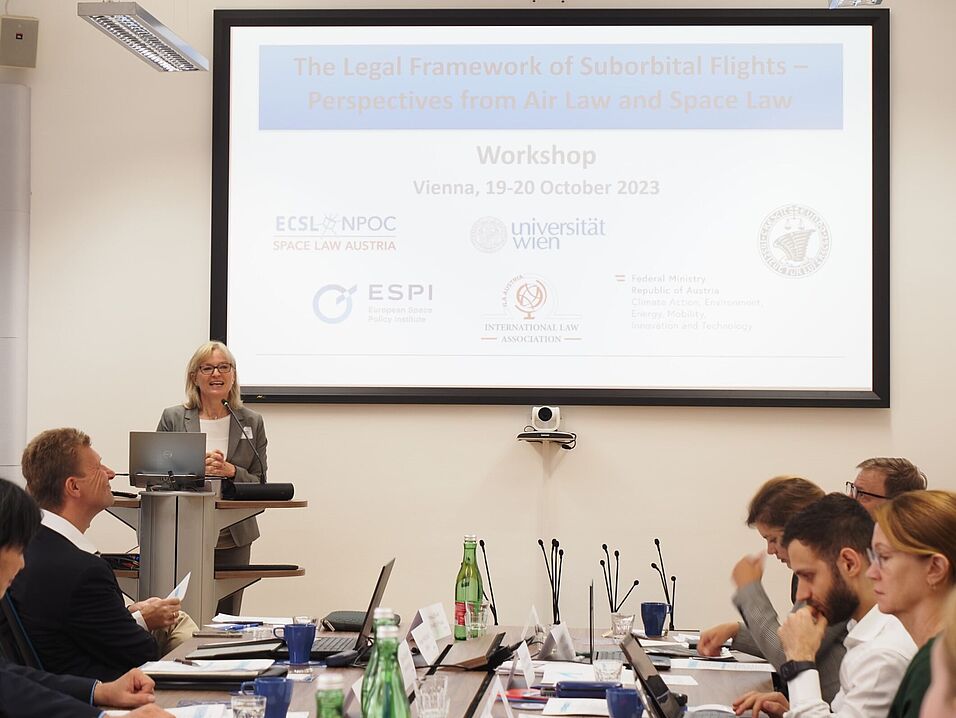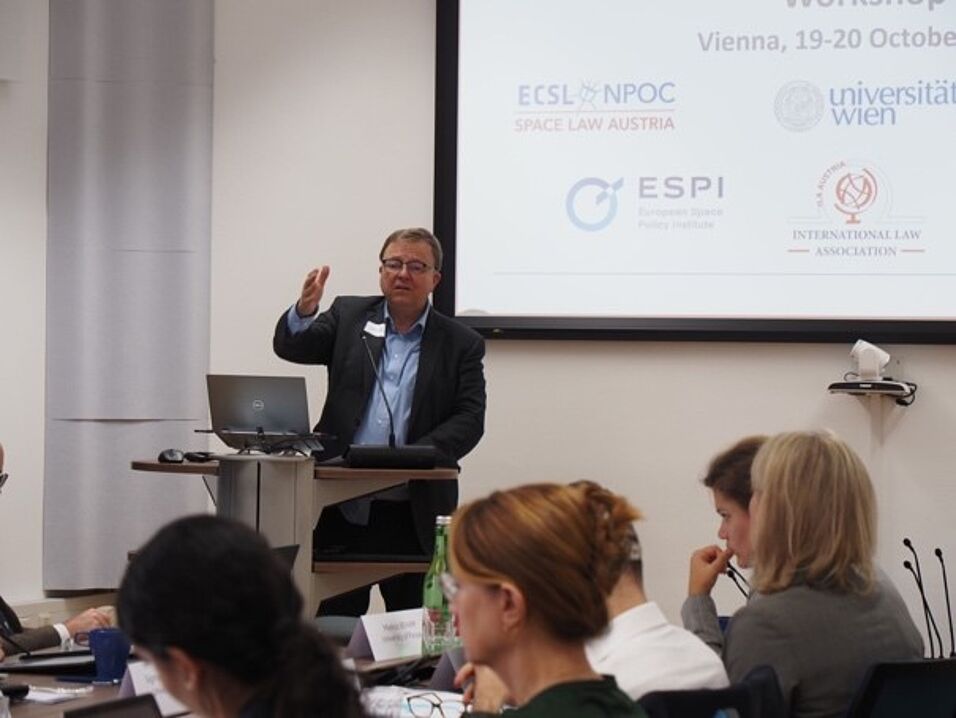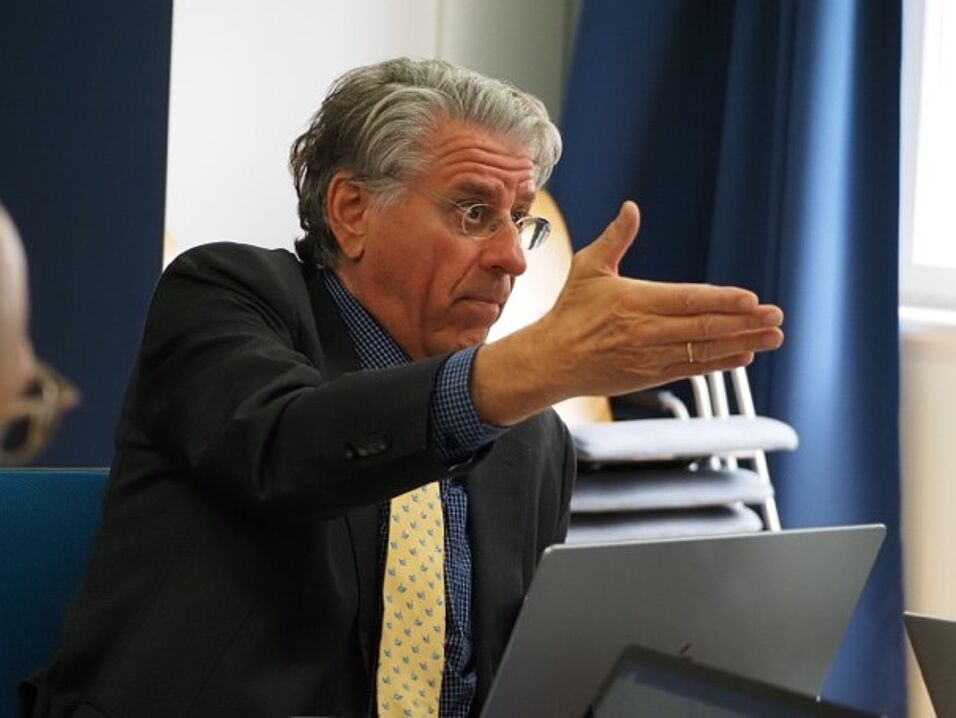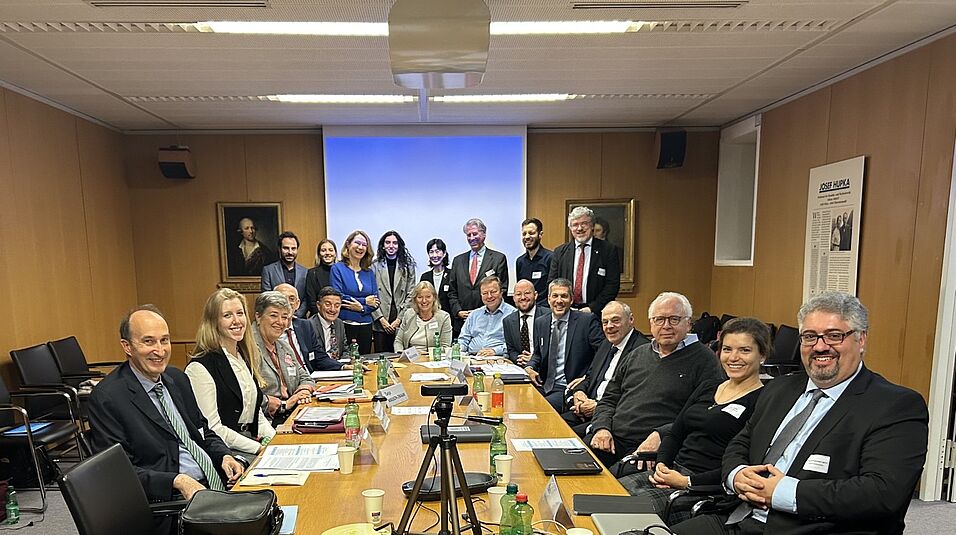Professor Irmgard Marboe, head of the Austrian NPOC for Space Law, and Professor Stephan Hobe (University of Cologne), chair of the ILA’s Space Law Committee co-hosted a workshop titled "The Legal Framework of Suborbital Flights – Perspectives from Air Law and Space Law" on 19 and 20 October 2023. The first day of the workshop took place at the premises of the European Space Policy Institute (ESPI), the second day in the Juridicum’s Josef-Hupka-room.
Suborbital flights in use
Suborbital flights have been used for science and research for a long time. So-called sounding rockets have been launched for measuring the atmosphere, weather conditions, and gravity experiments. More recently, private companies have developed ideas on commercial applications.
In 2021, private companies launched crewed suborbital flights for the first time. Suborbital flights are considered to represent a paradigm shift for space exploration and the start of a new era for commercial space travel. This transition is best exemplified by Virgin Galactic's VSS Unity spaceplane and Blue Origin's New Shepard rocket. Before these aircrafts safely return to the surface, space tourists experience a brief period of weightlessness as they cross the Kármán line, which marks the border between Earth's atmosphere and space. The shift to suborbital tourism marks a break from space exploration being a government-only project.
However, suborbital travel is not just for thrill seekers, as previously mentioned, it has potential applications in science as well, which have continuously expanded over time. For instance, suborbital flights offer an affordable platform for microgravity tests in areas such as materials science and medicine.
Open legal questions
In recent times, the rise of suborbital flights has posed a unique challenge to the international legal community, sparking debates on whether they should fall under the jurisdiction of air law, the law of outer space, or perhaps a distinct legal framework tailored to their characteristics. The ambiguity surrounding the legal status of these activities has prompted global attention and discussion on both aviation and space fronts.
At the 41st Session of the International Civil Aviation Organization (ICAO) Assembly, the spotlight shone on agenda item 31, which delved into the realm of Higher Airspace Operations. This session served as a platform for member states to grapple with the question of whether suborbital flights, with their trajectories stretching into the fringes of space, should be regulated primarily by air law.
Simultaneously, the 2023 session of the United Nations Committee on the Peaceful Uses of Outer Space (COPUOS) Legal Subcommittee dedicated agenda item 6(a) to a crucial discussion on the definition and delimitation of outer space. This reflects the growing recognition that the legal status of suborbital flights requires a comprehensive examination within the context of outer space law.
Recognizing the need for a nuanced approach, the Space Law Committee of the International Law Association (ILA) has been actively engaged in addressing the legal intricacies surrounding suborbital flights since 2016. By incorporating this issue into its agenda, the committee aims to identify key elements for a suitable legal framework. The committee has been diligent in presenting bi-annual progress reports, demonstrating a commitment to understanding the evolving landscape of suborbital activities. The ultimate goal of the ILA's Space Law Committee is to formulate a set of guidelines that can provide clarity for regulators navigating the complex intersection of air and space law. The result of these efforts will influence not just how suborbital travel develops in the future will also contribute to the broader discourse on the evolving dynamics of air and space law in the 21st century.
Aimed outcomes of the workshop
Considering the broad scope of application and legal uncertainties surrounding suborbital flights, outlined above, the workshop set out to clarify the most pressing open legal questions in this matter in order to ensure safety and reliability of suborbital activities as well as to guarantee health and environmental protection. Ultimately, it was the workshop´s goal to contribute to the previously mentioned difficult task of ILA of formulating a set of guidelines, which requires to gain a better understanding of the applicable law, air law or space law, international law or national law, or which combination.
Aiming to achieve these objectives, the workshop provided an exchange platform for experts hailing from diverse backgrounds, including academia, industry, and international organizations within the fields of aviation and space. Thereby a meaningful exchange of perspectives on the emerging challenges associated with defining and regulating high altitude activities was provided.
Participants comprised:
- Irmgard Marboe, University of Vienna (Co-Host)
- Stephan Hobe, University of Cologne (Co-Host)
- Sara Dalledonne, ESPI
- Otto Koudelka, TU Graz
- René Laufer, University of Technology
- Norbert Frischauf, Aerospace Expert and Consultant SIGMA-7
- Rafael Moro-Aguilar, Florida International University
- Markus Beham, University of Passau
- Sigmar Stadlmeier, University of Linz
- Elmar Giemulla, Embry-Riddle Aeronautical University and TU Berlin
- Konstantinos I. Andritsos, University of Cologne
- Setsuko Aoki, Keio University
- Mahulena Hofmann, University of Luxembourg
- Steven Freeland, Western Sydney University and Bond University
- Alexander Soucek, ESA
- Natercia Rodriguez, UNOOSA
- Tanja Masson-Zwaan, University of Leiden
- Wolf Müller-Rostin, Air Law Advisor
- Frans von der Dunk, University of Nebraska Lincoln
- Benjamyn I. Scott, University of Leiden
- Marco Pedrazzi, University of Milan
- Stephanie Stipsits, Ministry of Foreign Affairs of Austria
- Olavo Bittencourt Neto, Catholic University of Santos
- Sergio Marchisio, University La Sapienza
- Rada Popova, Isar Aerospace
Spanning over two days, the workshop featured seven panels, addressing various (legal) aspects of suborbital flights and activities. The participants engaged in discussions on a multitude of topics such as authorization and supervision, responsibility, liability, registration, the legal status of crews and passengers, insurance, and the regulation of facilities. The subjects of crew and passengers, and airports and spaceports were also addressed. Finally, the Workshop concluded with a debate on the future of suborbital flights and their legal framework.
The presentations held at the conference will be followed by a book, which shall appear in the series "Studies in Space Law", edited by Frans von der Dunk at Brill/Nijhoff. The book will reflect the variety of different perspectives, primarily from air law and space law, and also include views from scientists, engineers, and business representatives.




